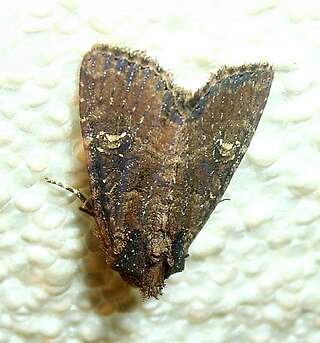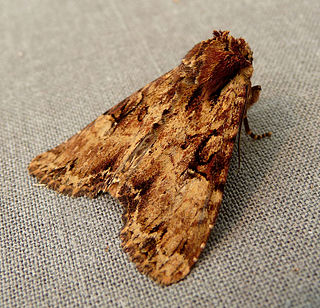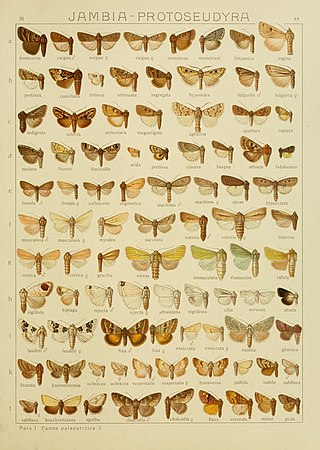
The minor shoulder-knot is a moth of the family Noctuidae. The species was first described by Johan Christian Fabricius in 1776. It is distributed throughout Europe then east across the Palearctic to Siberia and Japan. It also occurs in Turkey.

Apamea monoglypha, the dark arches, is a moth of the family Noctuidae. The species was first described by Johann Siegfried Hufnagel in 1766. It is a common, sometimes abundant, European species. It is found in most of Europe except northernmost Fennoscandia and the southern parts of the Iberian Peninsula and Greece. The species is also found in Anatolia, Turkestan, Western Asia and Central Asia, Siberia and Mongolia. In the Alps it is found up to heights of 2,500 meters. The smaller subspecies sardoa is found on Sardinia and Corsica.

Apamea crenata, known as the clouded-bordered brindle, is a moth in the family Noctuidae. It is distributed throughout the Palearctic realm. In the North it crosses the Arctic Circle, in the Mediterranean it is found only in cool locations and mountains avoiding very hot areas. In the Alps, it rises to an altitude of about 2000 metres.

Apamea remissa, the dusky brocade, is a species of moth of the family Noctuidae. It is distributed throughout Europe and Turkey, ranging across the Palearctic realm to Siberia, Manchuria and Japan. It has also been reported from Alaska.

Globia sparganii, or Webb's wainscot, is a moth of the family Noctuidae. The species was first described by Eugenius Johann Christoph Esper in 1790. It is found in Europe, Central Asia, from southern Siberia to Manchuria, Korea, Turkey, Syria and Iran.

Hypena rostralis, the buttoned snout, is a moth of the family Erebidae. It is found in Europe far into Scandinavia.Then through the Palearctic into Asia Minor, the Caucasus and east to Siberia. It is widespread at forest edges, forest clearings, shore areas, in gardens, park landscapes and cultivated land and rises in the mountains up to 1600 m.

Fissipunctia ypsillon, the dingy shears, is a species of moth of the family Noctuidae. It is found in the Palearctic realm.

Minucia lunaris, the lunar double-stripe or brown underwing, is a species of moth in the family Erebidae. The species was first described by Michael Denis and Ignaz Schiffermüller in 1775 and is found in Asia, Europe and North Africa.

Synthymia is a genus of moths of the family Noctuidae. It contains only one species, Synthymia fixa, The Goldwing, which is found in southern Europe and North Africa.

Catocala nymphagoga, the oak yellow underwing, is a moth of the family Erebidae. It is found in Southern Europe, from Bulgaria up to the Iberian Peninsula and sometimes further north as a migrant. It is also found in North Africa and Asia Minor.

Mesapamea secalis, the common rustic, is a moth of the family Noctuidae. The species was first described by Carl Linnaeus in his 1758 10th edition of Systema Naturae. It is found in Europe, north-west Africa, Turkey and northern Iran.

Agrotis vestigialis, the archer's dart, is a moth of the family Noctuidae. The species was first described by Johann Siegfried Hufnagel in 1766. It is found in most of the Palearctic realm from Ireland east, through to Russia, Siberia, the Altai mountains and the Amur region, and is also present in the Mediterranean Basin. It is absent from the north of Finland and Norway.

Apamea unanimis, the small clouded brindle, is a moth of the family Noctuidae. The species was first described by Jacob Hübner in 1813. It is native to Europe, Turkey, Azerbaijan, and western Siberia. It has been introduced in North America and can now be found in Ontario, Quebec, New Brunswick, New York, Michigan, and Wisconsin.

Lygephila craccae, the scarce blackneck, is a moth of the family Erebidae. It is found in temperate Europe and across the Palearctic to the Altai Mountains, Korea, Japan and China.

Agrotis trux, the crescent dart, is a moth of the family Noctuidae. The species was first described by Jacob Hübner in 1824. It has a circum-Mediterranean distribution and is found along the coasts of France, Ireland, England, southern Europe, Algeria, Syria, Iraq, Iran, southern Russia and the Arabian Peninsula. In Africa, it is found as far south as South Africa.

Apamea lateritia, the scarce brindle, is a moth of the family Noctuidae. It is found in much of the Palearctic. It is a sporadic migrant in Great Britain, where it is recorded from the east and south-east coasts.

Apamea oblonga, the crescent striped, is a moth of the family Noctuidae. The species was first described by Adrian Hardy Haworth in 1809. It is found in northern and central Europe, east to southern Russia, Asia Minor, Armenia, Turkestan, Turkey, Iran, southern Siberia, northern Pakistan, Mongolia, China, Sakhalin and Japan

Apamea anceps, the large nutmeg, is a moth of the family Noctuidae. The species was first described by Michael Denis and Ignaz Schiffermüller in 1775.

Apamea epomidion, the clouded brindle, is a moth of the family Noctuidae, sub-family Hadeninae. The species was first described by Adrian Hardy Haworth in 1809. It is found throughout continental Europe, the British Isles, Sweden and Central Asia. It is also found in the Altai Mountains, west Siberia, and in Amur.

Aegle semicana is a moth of the family Noctuidae. It was described by Eugenius Johann Christoph Esper in 1798. It is found in Austria, Italy, Hungary, former Yugoslavia, Romania, Bulgaria, Albania, Greece, Turkey, Russia, Libya, Egypt, Syria, Iraq, Iran and Israel, as well as on Sardinia, Sicily, Malta and Cyprus.






















